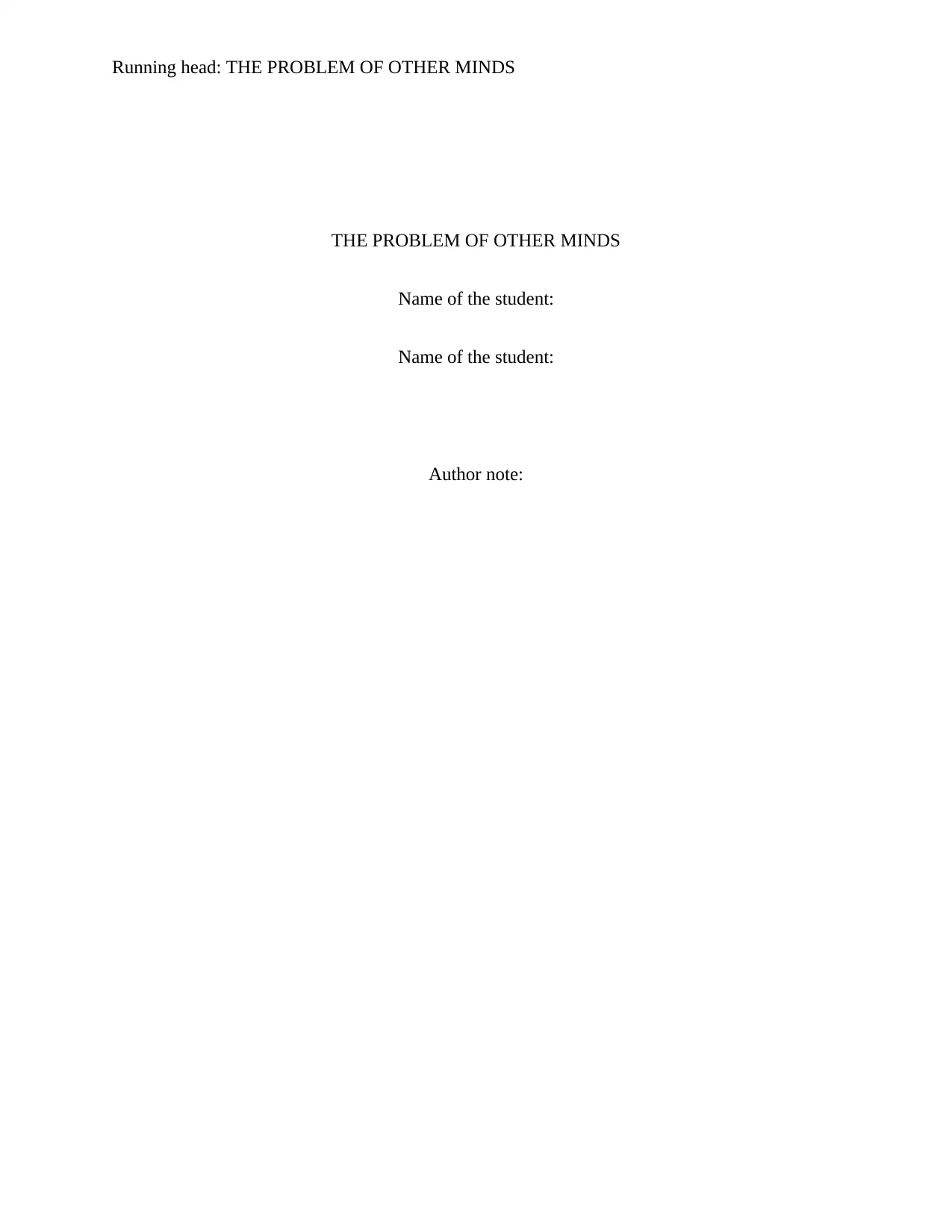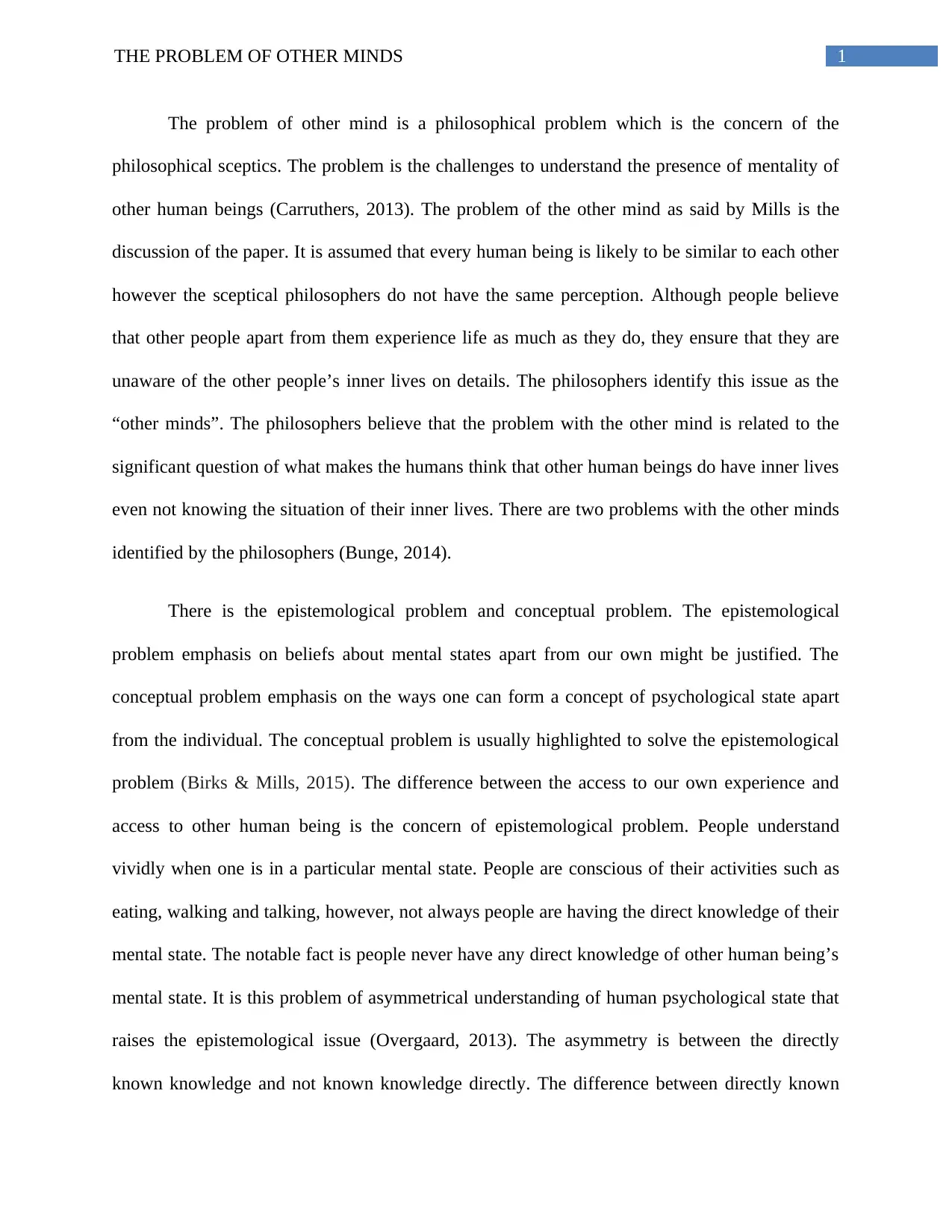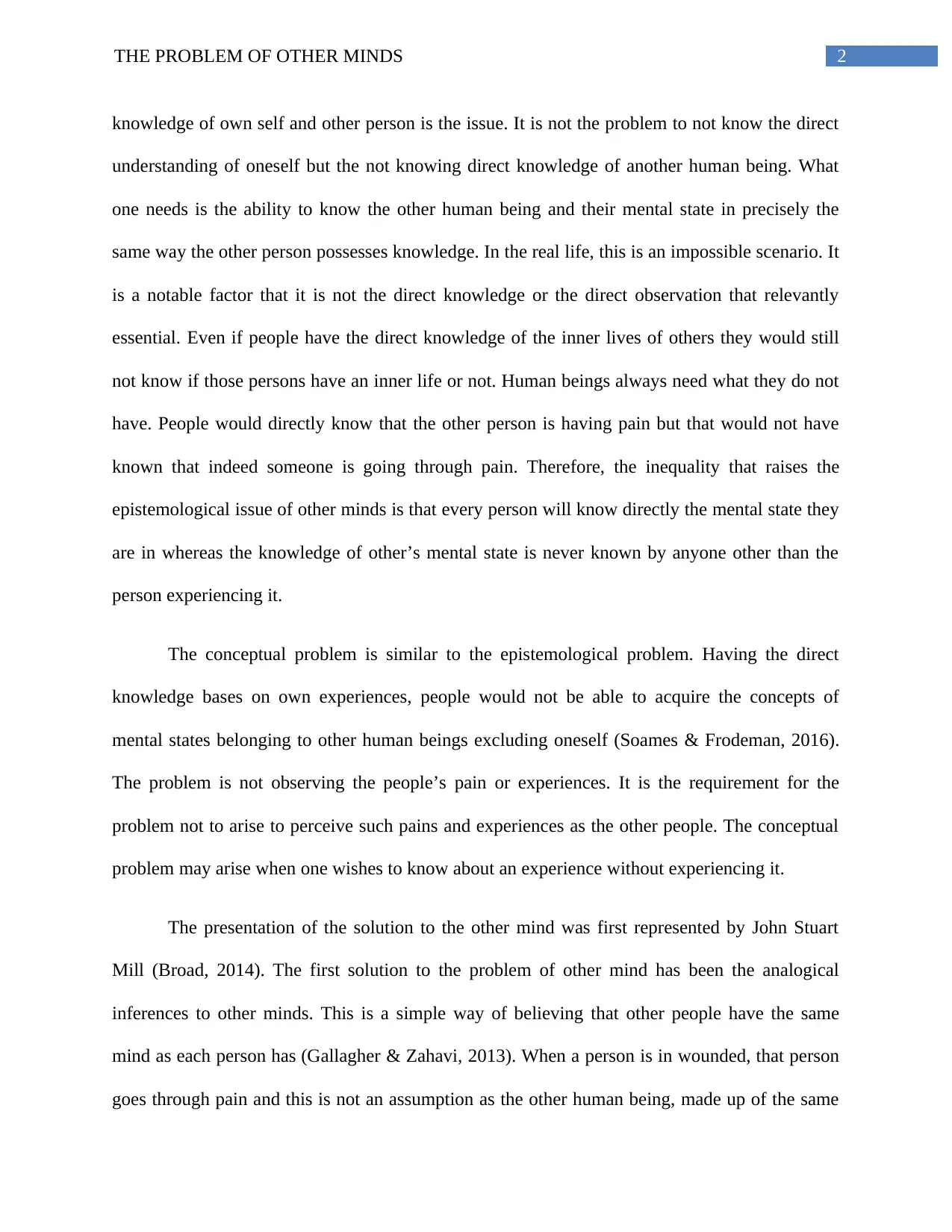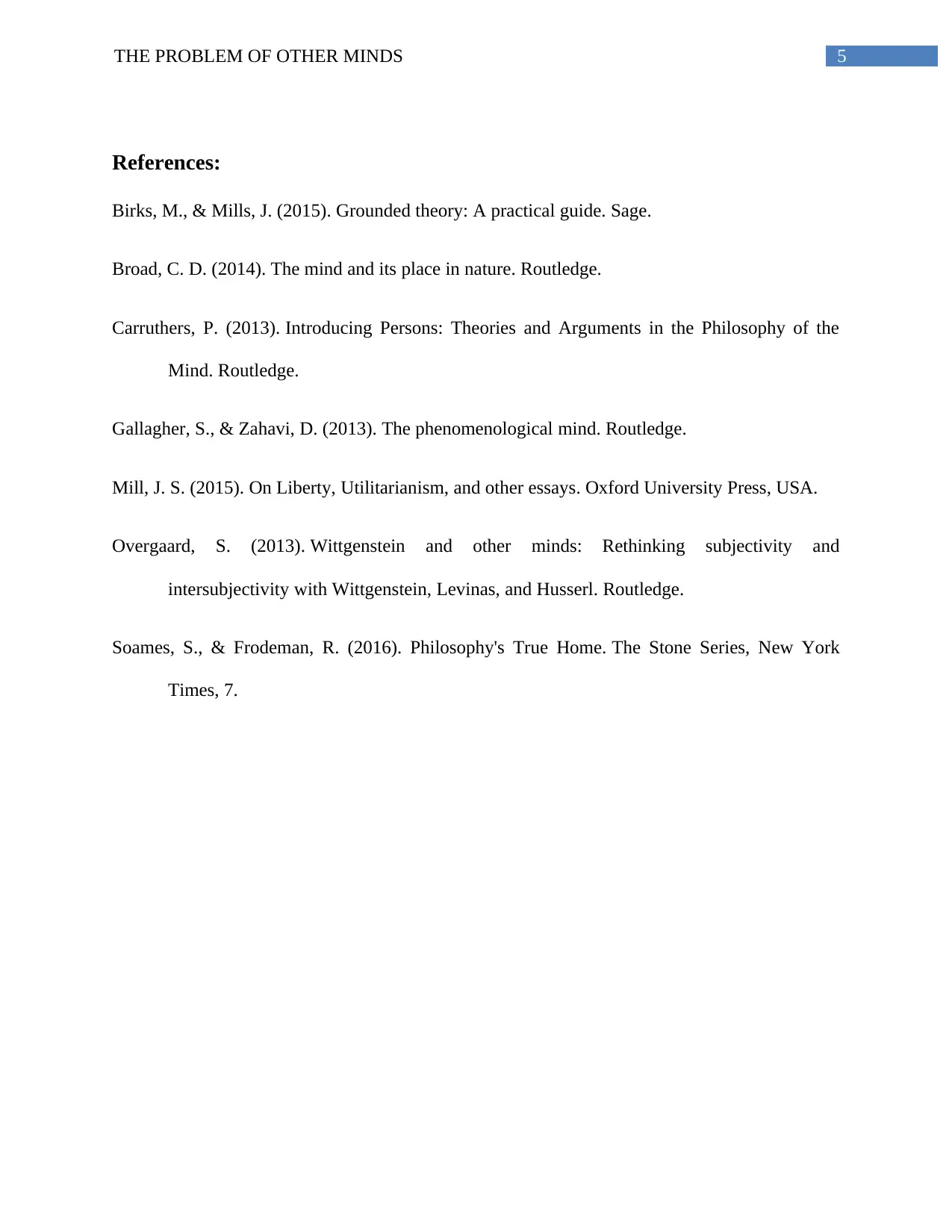The Problem of Other Minds: An Essay for PHIL 1101 Course
VerifiedAdded on 2023/06/10
|6
|1426
|212
Essay
AI Summary
This essay addresses the philosophical problem of other minds, focusing on the challenges of understanding the mental states of other individuals. It begins by defining the problem as a concern of philosophical skeptics, highlighting the difficulties in knowing the inner lives of others. The essay distinguishes between the epistemological and conceptual problems associated with the issue, emphasizing the asymmetry between our direct knowledge of our own experiences and our indirect understanding of others' mental states. It then delves into John Stuart Mill's proposed solution, which relies on analogical inferences based on the similarities between our own experiences and the observable behaviors of others. The essay examines Mill's argument, evaluates its strengths and weaknesses, and ultimately agrees with Mill's solution, suggesting that it provides a rational framework for understanding the minds of others, while acknowledging the inherent limitations in achieving direct knowledge of another person's mental state.

Running head: THE PROBLEM OF OTHER MINDS
THE PROBLEM OF OTHER MINDS
Name of the student:
Name of the student:
Author note:
THE PROBLEM OF OTHER MINDS
Name of the student:
Name of the student:
Author note:
Paraphrase This Document
Need a fresh take? Get an instant paraphrase of this document with our AI Paraphraser

1THE PROBLEM OF OTHER MINDS
The problem of other mind is a philosophical problem which is the concern of the
philosophical sceptics. The problem is the challenges to understand the presence of mentality of
other human beings (Carruthers, 2013). The problem of the other mind as said by Mills is the
discussion of the paper. It is assumed that every human being is likely to be similar to each other
however the sceptical philosophers do not have the same perception. Although people believe
that other people apart from them experience life as much as they do, they ensure that they are
unaware of the other people’s inner lives on details. The philosophers identify this issue as the
“other minds”. The philosophers believe that the problem with the other mind is related to the
significant question of what makes the humans think that other human beings do have inner lives
even not knowing the situation of their inner lives. There are two problems with the other minds
identified by the philosophers (Bunge, 2014).
There is the epistemological problem and conceptual problem. The epistemological
problem emphasis on beliefs about mental states apart from our own might be justified. The
conceptual problem emphasis on the ways one can form a concept of psychological state apart
from the individual. The conceptual problem is usually highlighted to solve the epistemological
problem (Birks & Mills, 2015). The difference between the access to our own experience and
access to other human being is the concern of epistemological problem. People understand
vividly when one is in a particular mental state. People are conscious of their activities such as
eating, walking and talking, however, not always people are having the direct knowledge of their
mental state. The notable fact is people never have any direct knowledge of other human being’s
mental state. It is this problem of asymmetrical understanding of human psychological state that
raises the epistemological issue (Overgaard, 2013). The asymmetry is between the directly
known knowledge and not known knowledge directly. The difference between directly known
The problem of other mind is a philosophical problem which is the concern of the
philosophical sceptics. The problem is the challenges to understand the presence of mentality of
other human beings (Carruthers, 2013). The problem of the other mind as said by Mills is the
discussion of the paper. It is assumed that every human being is likely to be similar to each other
however the sceptical philosophers do not have the same perception. Although people believe
that other people apart from them experience life as much as they do, they ensure that they are
unaware of the other people’s inner lives on details. The philosophers identify this issue as the
“other minds”. The philosophers believe that the problem with the other mind is related to the
significant question of what makes the humans think that other human beings do have inner lives
even not knowing the situation of their inner lives. There are two problems with the other minds
identified by the philosophers (Bunge, 2014).
There is the epistemological problem and conceptual problem. The epistemological
problem emphasis on beliefs about mental states apart from our own might be justified. The
conceptual problem emphasis on the ways one can form a concept of psychological state apart
from the individual. The conceptual problem is usually highlighted to solve the epistemological
problem (Birks & Mills, 2015). The difference between the access to our own experience and
access to other human being is the concern of epistemological problem. People understand
vividly when one is in a particular mental state. People are conscious of their activities such as
eating, walking and talking, however, not always people are having the direct knowledge of their
mental state. The notable fact is people never have any direct knowledge of other human being’s
mental state. It is this problem of asymmetrical understanding of human psychological state that
raises the epistemological issue (Overgaard, 2013). The asymmetry is between the directly
known knowledge and not known knowledge directly. The difference between directly known

2THE PROBLEM OF OTHER MINDS
knowledge of own self and other person is the issue. It is not the problem to not know the direct
understanding of oneself but the not knowing direct knowledge of another human being. What
one needs is the ability to know the other human being and their mental state in precisely the
same way the other person possesses knowledge. In the real life, this is an impossible scenario. It
is a notable factor that it is not the direct knowledge or the direct observation that relevantly
essential. Even if people have the direct knowledge of the inner lives of others they would still
not know if those persons have an inner life or not. Human beings always need what they do not
have. People would directly know that the other person is having pain but that would not have
known that indeed someone is going through pain. Therefore, the inequality that raises the
epistemological issue of other minds is that every person will know directly the mental state they
are in whereas the knowledge of other’s mental state is never known by anyone other than the
person experiencing it.
The conceptual problem is similar to the epistemological problem. Having the direct
knowledge bases on own experiences, people would not be able to acquire the concepts of
mental states belonging to other human beings excluding oneself (Soames & Frodeman, 2016).
The problem is not observing the people’s pain or experiences. It is the requirement for the
problem not to arise to perceive such pains and experiences as the other people. The conceptual
problem may arise when one wishes to know about an experience without experiencing it.
The presentation of the solution to the other mind was first represented by John Stuart
Mill (Broad, 2014). The first solution to the problem of other mind has been the analogical
inferences to other minds. This is a simple way of believing that other people have the same
mind as each person has (Gallagher & Zahavi, 2013). When a person is in wounded, that person
goes through pain and this is not an assumption as the other human being, made up of the same
knowledge of own self and other person is the issue. It is not the problem to not know the direct
understanding of oneself but the not knowing direct knowledge of another human being. What
one needs is the ability to know the other human being and their mental state in precisely the
same way the other person possesses knowledge. In the real life, this is an impossible scenario. It
is a notable factor that it is not the direct knowledge or the direct observation that relevantly
essential. Even if people have the direct knowledge of the inner lives of others they would still
not know if those persons have an inner life or not. Human beings always need what they do not
have. People would directly know that the other person is having pain but that would not have
known that indeed someone is going through pain. Therefore, the inequality that raises the
epistemological issue of other minds is that every person will know directly the mental state they
are in whereas the knowledge of other’s mental state is never known by anyone other than the
person experiencing it.
The conceptual problem is similar to the epistemological problem. Having the direct
knowledge bases on own experiences, people would not be able to acquire the concepts of
mental states belonging to other human beings excluding oneself (Soames & Frodeman, 2016).
The problem is not observing the people’s pain or experiences. It is the requirement for the
problem not to arise to perceive such pains and experiences as the other people. The conceptual
problem may arise when one wishes to know about an experience without experiencing it.
The presentation of the solution to the other mind was first represented by John Stuart
Mill (Broad, 2014). The first solution to the problem of other mind has been the analogical
inferences to other minds. This is a simple way of believing that other people have the same
mind as each person has (Gallagher & Zahavi, 2013). When a person is in wounded, that person
goes through pain and this is not an assumption as the other human being, made up of the same
⊘ This is a preview!⊘
Do you want full access?
Subscribe today to unlock all pages.

Trusted by 1+ million students worldwide

3THE PROBLEM OF OTHER MINDS
components, will experience the same feeling. A person gets to know from its own experience
how other people will feel when going through the same circumstances. According to Mill
(2015), a person easily assumes other people with a mind that can states about the other person’s
behaviour and mental state because people see the similarity in external features. A person is
aware of its behaviour that is guided by its mind. The person understands how its mind is
responsible for its behaviour and thinking, therefore, it is rational to assume the same for the
other people around. The argument can be termed as a general sense of how to solve the problem
of other minds. However, one can object to its use of induction. The conclusion is that other
people’s mind is similar to mine. On the basis of casual relation the single case of one’s
behaviour and mind, it can be summarised that there are behaviours that are due to the presence
of minds.
The solution to the other mind presented by John Stuart Mill is defiantly agreeable. He
has given the most rational solution, which makes the base of thinking. It is evitable for a person
to assume another person with mind since one can see what the mind does. Although one’s way
of behaving is depended on the experiences and learning along with the time when the question
arises of other persons having a mind, it goes all the way to the basic. The difference is to
compare the ability of the mind and not the presence of mind. People can conceptualise the
concepts that are experienced by them and also secure. However, the concepts that one has not
experienced is hard to conceptualise as one is unaware of the direct knowledge of the experience.
The conceptualising of the experience is dependent on one’s experience of life. The question that
should be raised is the ability of the mind of a human being not the presence of mind. Therefore
it is agreeable with the analogy of John Stuart Mill. An exception would be with a person who is
mentally unstable biologically. A person possessing a biologically healthy mind and body would
components, will experience the same feeling. A person gets to know from its own experience
how other people will feel when going through the same circumstances. According to Mill
(2015), a person easily assumes other people with a mind that can states about the other person’s
behaviour and mental state because people see the similarity in external features. A person is
aware of its behaviour that is guided by its mind. The person understands how its mind is
responsible for its behaviour and thinking, therefore, it is rational to assume the same for the
other people around. The argument can be termed as a general sense of how to solve the problem
of other minds. However, one can object to its use of induction. The conclusion is that other
people’s mind is similar to mine. On the basis of casual relation the single case of one’s
behaviour and mind, it can be summarised that there are behaviours that are due to the presence
of minds.
The solution to the other mind presented by John Stuart Mill is defiantly agreeable. He
has given the most rational solution, which makes the base of thinking. It is evitable for a person
to assume another person with mind since one can see what the mind does. Although one’s way
of behaving is depended on the experiences and learning along with the time when the question
arises of other persons having a mind, it goes all the way to the basic. The difference is to
compare the ability of the mind and not the presence of mind. People can conceptualise the
concepts that are experienced by them and also secure. However, the concepts that one has not
experienced is hard to conceptualise as one is unaware of the direct knowledge of the experience.
The conceptualising of the experience is dependent on one’s experience of life. The question that
should be raised is the ability of the mind of a human being not the presence of mind. Therefore
it is agreeable with the analogy of John Stuart Mill. An exception would be with a person who is
mentally unstable biologically. A person possessing a biologically healthy mind and body would
Paraphrase This Document
Need a fresh take? Get an instant paraphrase of this document with our AI Paraphraser

4THE PROBLEM OF OTHER MINDS
experience life, however; the knowledge of the mental state of other people will never be
achievable. Since the Mill’s solution provides a rationalised solution, the essay agrees with the
settlement of Mills.
experience life, however; the knowledge of the mental state of other people will never be
achievable. Since the Mill’s solution provides a rationalised solution, the essay agrees with the
settlement of Mills.

5THE PROBLEM OF OTHER MINDS
References:
Birks, M., & Mills, J. (2015). Grounded theory: A practical guide. Sage.
Broad, C. D. (2014). The mind and its place in nature. Routledge.
Carruthers, P. (2013). Introducing Persons: Theories and Arguments in the Philosophy of the
Mind. Routledge.
Gallagher, S., & Zahavi, D. (2013). The phenomenological mind. Routledge.
Mill, J. S. (2015). On Liberty, Utilitarianism, and other essays. Oxford University Press, USA.
Overgaard, S. (2013). Wittgenstein and other minds: Rethinking subjectivity and
intersubjectivity with Wittgenstein, Levinas, and Husserl. Routledge.
Soames, S., & Frodeman, R. (2016). Philosophy's True Home. The Stone Series, New York
Times, 7.
References:
Birks, M., & Mills, J. (2015). Grounded theory: A practical guide. Sage.
Broad, C. D. (2014). The mind and its place in nature. Routledge.
Carruthers, P. (2013). Introducing Persons: Theories and Arguments in the Philosophy of the
Mind. Routledge.
Gallagher, S., & Zahavi, D. (2013). The phenomenological mind. Routledge.
Mill, J. S. (2015). On Liberty, Utilitarianism, and other essays. Oxford University Press, USA.
Overgaard, S. (2013). Wittgenstein and other minds: Rethinking subjectivity and
intersubjectivity with Wittgenstein, Levinas, and Husserl. Routledge.
Soames, S., & Frodeman, R. (2016). Philosophy's True Home. The Stone Series, New York
Times, 7.
⊘ This is a preview!⊘
Do you want full access?
Subscribe today to unlock all pages.

Trusted by 1+ million students worldwide
1 out of 6
Related Documents
Your All-in-One AI-Powered Toolkit for Academic Success.
+13062052269
info@desklib.com
Available 24*7 on WhatsApp / Email
![[object Object]](/_next/static/media/star-bottom.7253800d.svg)
Unlock your academic potential
Copyright © 2020–2025 A2Z Services. All Rights Reserved. Developed and managed by ZUCOL.




